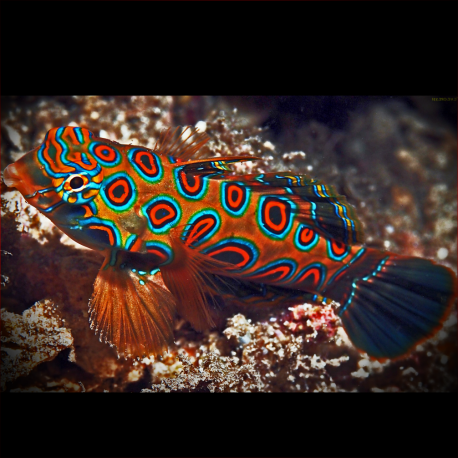More info
Datasheet
| Minimum Tank Size | 200 litres / 52.83 US gallons |
| Maximum Size | 6.0cm / 2.36inches |
| Reef Compatible | Always reef safe |
| Temperament | Mostly peaceful but might be aggressive towards similar species |
| Temperature | 22.2°C / 71.96°F - 25.6°C / 78.08°F |
| Specific Gravity | 1.020-1.025 |
| Carbonate Hardness | 8-12 |
| pH | 8.1-8.4 |
General Description
The Picturesque dragonet, scientifically known as Synchiropus picturatus, belongs to the Callionymidae family and is commonly referred to as the Green spot mandarin, Painted dragonet, or Picturesque dragonet. These colorful fish are native to the Indo-West Pacific regions, particularly found in the Philippines, eastern Indonesia, and northwest Australia. They are relatively small in size, reaching up to 6.0cm at maturity. Dragonets are known to stay close to the tank bottom and among rocks, seldom venturing into open water. They primarily feed on small pods present on rocks.
Aquarium Suitability and Demands
The Picturesque dragonet is considered suitable for aquariums with caution. They thrive best in established tanks with an abundant population of pods, making them ideal for systems that have been active for approximately a year or teeming with pods. It is essential to ensure their dietary needs are met to maintain their health and peaceful behavior. While multiple dragonets can coexist, it is advisable to avoid keeping two males simultaneously. Dragonets are susceptible to anemones predation and are relatively resistant to common parasites, but sensitive to copper-based medications.
Care and Hardiness
Characterized as having an average hardiness level, these dragonets require good hiding spots, typically among live rocks. Before acquiring them, ensuring a tank filled with an ample number of pods is crucial. They can be challenging to transition to frozen foods and may require substantial efforts to acclimate. Optimal water conditions with a pH range of 8.1-8.4, a specific gravity of 1.020-1.025, and a temperature between 22.2-25.6°C are recommended for their well-being.
Reef Suitability
Picturesque dragonets are known to be reef-compatible and are generally considered safe within a reef environment. Their peaceful temperament makes them a suitable addition to reef tanks, provided there is an adequate population of pods to sustain them.
Aquarium Setup
When setting up an aquarium for Picturesque dragonets, it is crucial to have ample live rocks with hiding places to mimic their natural habitat. Ensure the tank has been running for a sufficient period to establish a robust pod population. Incorporating a feeding device or supplementing with live zooplankton may be necessary to meet their dietary requirements if they do not readily accept frozen foods.
Behaviour
Dragonets are mostly peaceful, but they can exhibit aggression towards similar species, particularly towards other males. Their behavior is primarily characterized by remaining close to the tank bottom and among rocks, displaying a shy and cautious nature.
Feeding and Diet
The recommended diet for Picturesque dragonets includes small crustaceans like krill, mysis, and artemia, along with zooplankton such as cyclops and pods. While some individuals may adapt to consuming frozen foods over time, ensuring a diverse and high-quality diet is essential for their nutritional needs.
Dimorphism and Captive Reproduction
Male dragonets typically exhibit stronger colors and larger front dorsal fins compared to females. They can be bred successfully in captivity, making them a potential option for enthusiasts interested in breeding these colorful fish. Seeking captive-bred specimens from local fish stores is encouraged to support sustainable practices in the hobby.
Habitat and Distribution
Picturesque dragonets are commonly found in the Indo-West Pacific regions, particularly in the Philippines, eastern Indonesia, and northwest Australia. Their natural habitat consists of rocky areas with ample populations of small pods, which serve as their primary food source in the wild.

